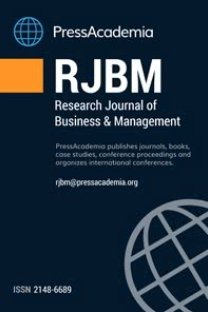MEASURES TO PREVENT LISTED FIRMS FROM BEING EMPTIED: THE CASE OF TAIWAN
Empty out, governance ethics, fraud, enterprise value,
___
- Adolf A. Berle, Jr. & Gardiner C. Means, (1932). The modern corporation and private property. New York: The Macmillan Company.
- Bowen, H. R. (1953). Social responsibility of the businessman, New York: Harper & Row.
- Carroll, A. B. (1979). A three-dimensional conceptual model of corporate social performance. Academy of Management Review, vol. 4, no. 4, pp.497-505.
- Cohen, J. Ding, Y. Lesage, C. & Stolowy, H. (2010). Corporate fraud and managers’ behavior: evidence from the press. Journal of Business Ethics, vol. 95, pp.271–315.
- Cochran, P & Wartick, S. (1988). Corporate governance: a review of the literature. Financial Executives Research Foundation, Morristown, New Jersey.
- Dalkey & Helmer, (1962). An experimental application of the delphi method to the use of experts, United States Air Force Project Rand.
- Dalkey, N. C. (1969). The Delphi method: An experimental study of group opinion, Santa Monica, CA: The Rand Corporation.
- Delbecq, A. L., Van de Ven, A. H., & Gustafson, D. H. (1975). Group techniques for program planning: A guide to nominal group and Delphi processes, Glenview, Ill.: Scott, Foresman.
- Enofe, A. O., Omagbon, P. & Ehigiator, F. I. (2015). Forensic audit and corporate fraud. International Journal of Economics and Business Management, vol. 1, no.7, pp.1-10.
- Ferrell, Fraedrich & Ferrell, (2002). Business ethics: ethical decision making & cases, 8th Edition, South-Western, Cengage Learning.
- Fleming, A. S., Hermanson, D. R., Kranacher, M. J. & Riley, R. A. (2016). Financial reporting fraud: public and private companies. Journal of Forensic Accounting Research. vol. 1, no. 1, pp. A27-A41.
- Hill, K. Q. & J. Fowles, (1975). The methodological worth of the delphi forecasting technique, Technological Forecasting and Social Change, vol.7, pp.179-192.
- Jensen & Meckling, (1976). Theory of the firm: managerial behavior, bgency costs and ownership structure, New York: John Wiley & Sons, Inc.
- OECD, (2016). G20/OECD Principles of Corporate Governance.
- Romney, M. B., Albrecht, W. S. & Cherrington, D.J. (1980). Red-flagging the white collar criminal. Management Accounting, May, pp.51-57.
- Rezaee, Z. (2002). Financial statement fraud: prevention and detection, New York: John Wiley & Sons, Inc.
- Rommey, M. B., Albrecht, W. S. & Cherrington, D. J. (1980). Auditors and the detection of fraud. Journal of Accountancy, vol. 49, no. 5, pp.63-69.
- Shleifer & Vishny, (1997). A survey of corporate governance. The Journal of Finance, vol. LII, no. 2, pp.737-783.
- Steiner, G. A. & Steiner, J. F. (1980). Business, government and society: a management perspective. New York: Random House.
- Wolfe, D. T & Hermanson, D. R. (2004). The fraud diamond: considering the four elements of fraud. The CPA Journal, vol. 74, no. 12, pp.38-45.
- Zkul, F. U. & Pamukc, A. (2012). Fraud detection and forensic accounting. Springer-Verlag, Berlin, Heidelberg.
- Yayın Aralığı: Yılda 4 Sayı
- Başlangıç: 2014
- Yayıncı: PressAcademia
Pinar ACAR, Mujdelen İ. YENER, Asli TAYAN
Jing-yin CHAN, Yao-hsien LEE, She-juang LUO, Li-yang HSİEH
Hewa Kumbalgoda Gamage Sriyani RANASİNGHE, Mohd Shukri Abd. YAJİD, Ali KHATİBİ
